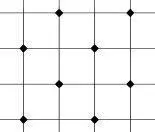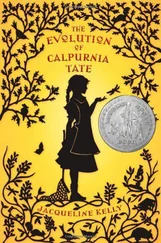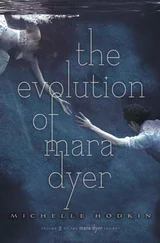Behind the ellipsoidal cherrywood dining table, directly opposite the front door, a sliding glass door (21) opens onto a small patch of backyard, which features a red brick patio and a square of grass surrounded by low-cut hedges, in which tulips grow in the spring.
At this point the living/dining room spills into a cramped and narrow but serviceable kitchen (22), its perimeter defined by the line where the wood floor becomes tile. (The pattern of the kitchen floor tile is big beige tiles set in a grid with smaller, diamond-shaped tiles of lazulian blue set in every other conjuncture of four tile corners. Like this:
 .) The kitchen features the following amenities, listed counterclockwise from the northwest corner of the room: pantry (23), counter (24), sink (25), dishwasher (26), counter (27), cabinets (28), oven/stove (29), counter (30), refrigerator (31). The stove is gas; the countertops are of speckled pink Formica; a coffeemaker, a toaster, and a microwave sit to the left of the sink; the wooden cabinets are built into the wall; a window above the kitchen sink looks out into the backyard and the alley just beyond it; three potted philodendrons stand in a row on the windowsill; the kitchen walls are painted pale yellow. The refrigerator is white, and several magnets cling to the surface of its door, pinning in place some slightly unfocused snapshots of Lydia smiling cameraward in the company of various unidentified friends, relatives, or loved ones.
.) The kitchen features the following amenities, listed counterclockwise from the northwest corner of the room: pantry (23), counter (24), sink (25), dishwasher (26), counter (27), cabinets (28), oven/stove (29), counter (30), refrigerator (31). The stove is gas; the countertops are of speckled pink Formica; a coffeemaker, a toaster, and a microwave sit to the left of the sink; the wooden cabinets are built into the wall; a window above the kitchen sink looks out into the backyard and the alley just beyond it; three potted philodendrons stand in a row on the windowsill; the kitchen walls are painted pale yellow. The refrigerator is white, and several magnets cling to the surface of its door, pinning in place some slightly unfocused snapshots of Lydia smiling cameraward in the company of various unidentified friends, relatives, or loved ones.
In one of the photographs, Lydia is sitting in the company of three other women, all of whom appear to be about her age. They are all smiling. They are wearing bright swimwear: indeed, they appear to be wearing little but enough clothing to cover their breasts and genitals; their smiles are wide and seemingly genuine; their eyes are shadowed behind sunglasses. Lydia is wearing a canary yellow swimsuit. The women sit together at a table beneath a pink umbrella, on what looks like the outdoor patio of a restaurant, in a sunny, pleasant place that is very far away from here, both geographically and psychologically. The three other women are holding drinking glasses whose stems slope curvilinearly upward into elaborate shapes, containing unknown liquids, decorated with tiny umbrellas and colorful straws that twist up from the bowls of the glasses. Lydia, situated at the far left of the photograph, is conspicuously the only person in the photograph not holding one of these colorful beverages; in Lydia’s hand there appears to be only an ordinary glass of orange juice. Lydia also looks oddly swollen in the picture, with a considerable belly that looks out of proportion to the rest of her body.
Rounding the corner of the half wall that helps define the boundaries of the kitchen, we pass back through the central living area, which empties into a dim chute of a hallway (32); at the mouth of the hallway the hardwood flooring ends and the dun gray carpeting begins; this short hallway has four doors: two on the left, one on the right, and one at the very end. The door on the right leads to a small room that a Realtor would call.5 of a bathroom (33): mirror, sink, toilet, shower, and tile floor of the same pattern as the kitchen floor. (I apologize that I have not bothered to render these things in detail.) The door at the very end of the hall leads to the master bedroom (34), or in our case the mistress bedroom, I suppose: Lydia’s room. A wooden four-poster queen-size bed (35) dominates the room; the headboard is pushed flush against the south wall; the bed is probably made and draped with a down lavender comforter. Directly opposite the bed a bookshelf (36), fully stocked with dense and difficult volumes on academic subjects, lines the north wall. The bed is flanked on the right by a sleekly architectonic designer lamp that swivels on a long stalk (37) and on the left by a plain wooden bedside night table (38), and to the left of that, in the corner of the room, stands a sturdy chest of drawers (39). Two more windows in the east wall of the room look onto the street, treated with dark red curtains identical to the ones in the living room. On the south wall of the room hangs a framed print of Charles Demuth’s I Saw the Figure 5 in Gold . On the bedside night table are an alarm clock (not pictured) and two more framed photographs (40, 41).
The first photograph, vertically oriented, shows Lydia standing in an unknown location, and standing in it with a man, both of them barefoot, their toes partially buried in the wet sand, on what looks like a beach. The wet sand is a jumble of footprints. This photograph is also a synesthetic one, its image easily implying sound and smell, the skweee-skweee of seagulls almost audible in it, the brackish seaside air almost olfactible. On a rocky hill in the background behind them stand three whitewashed stone windmills, each successively smaller than the next as the ridge they’re built on curls into the distance, each windmill with a thatched conical roof and a pinwheel fashioned of rickety wooden spokes. The sky is blue, fading toward the horizon into dusky orange and then purple, and the light on the ground, on the two people themselves, and on the white trunks of the three windmills is sharp and golden, and the shadows are long. The shadow of the anonymous photographer stretches far into the frame across the golden sand. Lydia wears a breezy white shirt and a pair of white pants with a drawstring waistband, the bottom hems of which are rolled up to her knees, and her feet and ankles are covered with sand; the man is also wearing white pants with the bottom hems rolled up, in his case not quite to the knees, and below a line in the middle of his shin all his leg hair is flattened wet against his skin and speckled with sand particles. Lydia’s blond hair is whipping erratically in the wind, although one of her hands is caught in the act of trying to tuck some of her hair behind her ear. But the other hand? The other hand is wrapped around the waist of the man beside her. And the man beside her? I’ll admit that he is probably handsome. I’ll admit that his physique is somewhat Adonis-like, that one might consider him tall and the possessor of arguably chiseled features, that his skin could conceivably be described as tanned and robust. I’m also willing to concede that one of his perceivably lean and muscular arms is depicted in the act of insidiously wrapping itself around Lydia’s torso, and that if one looks closely, the tips of his fingers may in fact be, as is not unequivocally deducible from the image before us, digging slightly beneath the waistline of the pants that Lydia wears in the photograph, where they may or may not be in the process of deftly stroking the ridge of her right hipbone. I’m also perfectly willing to admit that these two people are both smiling in an apparently genuine way as they squint into the setting sun, and I will admit these two people are, perhaps, at least ostensibly, not impossibly, seemingly outwardly clearly painfully obviously deeply in love. But I will not admit that this photograph ever made me jealous.
In the other photograph, the same two people, Lydia and the mysterious man, are standing in some indoor area; unlike the other, this photograph is not a snapshot but rather has been deliberately, professionally staged. Lydia, barely recognizable in the picture, is wearing a long white dress, blinding white, which spills from her beautiful bare shoulders like a frothing waterfall, and her outfit is accompanied by a white headband with a long diaphanous sheet of fabric sprouting from it and trailing down behind her. The man is standing beside her, again, with his arm planted on Lydia’s opposite hip, wearing black. I know now what this photograph indicated. I didn’t then.
Читать дальше

 .) The kitchen features the following amenities, listed counterclockwise from the northwest corner of the room: pantry (23), counter (24), sink (25), dishwasher (26), counter (27), cabinets (28), oven/stove (29), counter (30), refrigerator (31). The stove is gas; the countertops are of speckled pink Formica; a coffeemaker, a toaster, and a microwave sit to the left of the sink; the wooden cabinets are built into the wall; a window above the kitchen sink looks out into the backyard and the alley just beyond it; three potted philodendrons stand in a row on the windowsill; the kitchen walls are painted pale yellow. The refrigerator is white, and several magnets cling to the surface of its door, pinning in place some slightly unfocused snapshots of Lydia smiling cameraward in the company of various unidentified friends, relatives, or loved ones.
.) The kitchen features the following amenities, listed counterclockwise from the northwest corner of the room: pantry (23), counter (24), sink (25), dishwasher (26), counter (27), cabinets (28), oven/stove (29), counter (30), refrigerator (31). The stove is gas; the countertops are of speckled pink Formica; a coffeemaker, a toaster, and a microwave sit to the left of the sink; the wooden cabinets are built into the wall; a window above the kitchen sink looks out into the backyard and the alley just beyond it; three potted philodendrons stand in a row on the windowsill; the kitchen walls are painted pale yellow. The refrigerator is white, and several magnets cling to the surface of its door, pinning in place some slightly unfocused snapshots of Lydia smiling cameraward in the company of various unidentified friends, relatives, or loved ones.










